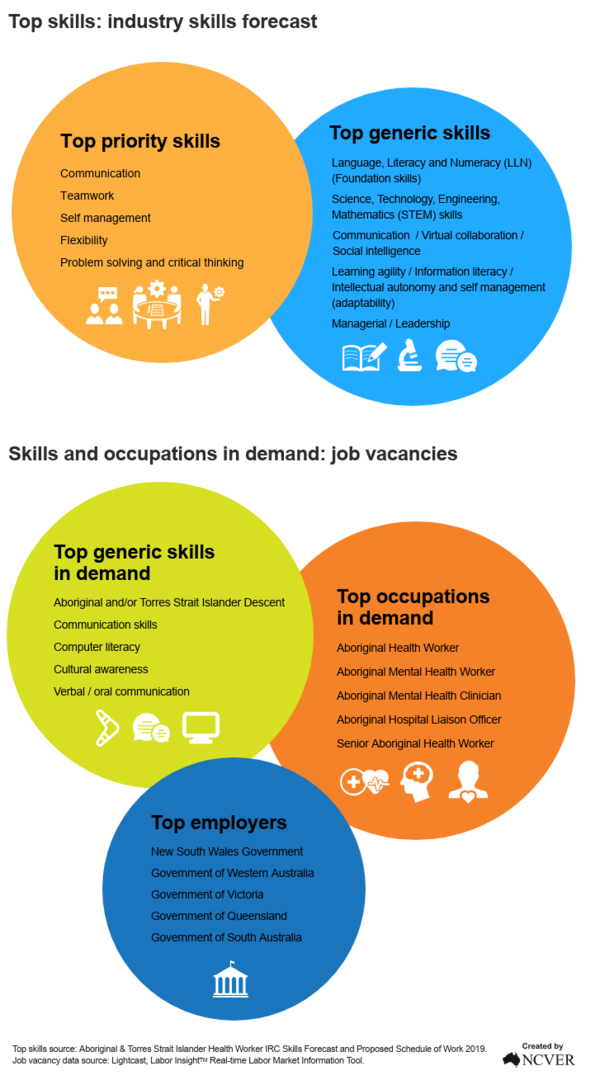
Industry insights on skills needs
The Aboriginal and Torres Strait Islander Health Worker IRC's Skills Forecast – 2020 Update (hereafter the 2020 Annual Update) was the most recently published industry skills forecast, as of September 2022. It identified the top five short-to-medium term skills considered extremely important across the Aboriginal and Torres Strait Islander Health workforce as communication, teamwork, self-management, flexibility, and problem solving and critical thinking. Skills involved in the early detection and intervention of health needs are also important for the future workforce.
According to job vacancy data, the top requested attributes and skills by employers in the sector were Aboriginal and/or Torres Strait Islander descent and communication skills. The most advertised occupations were Aboriginal Health Worker, followed by Aboriginal Mental Health Worker. The top employers were the New South Wales Government and the Government of Western Australia.
In 2019, the Aboriginal and Torres Strait Islander Health Worker IRC identified several workforce challenges, summarised as a lack of career progression opportunities, government policy and legislation changes, and skills and workforce supply shortages. More recently, in the 2020 Annual Update, the IRC included the impact of COVID-19 and regulatory developments regarding capability requirements, as well as the aforementioned workforce challenges. Further information about the impact of COVID-19 is below.
Regulatory developments
The National Agreement on Closing the Gap, signed in mid-2020, represents a different approach to the delivery of government services, with all Australian governments working with Aboriginal and Torres Strait Islander people, their communities, organisations and businesses. The Commonwealth Closing the Gap Implementation Plan provides a snapshot of the Commonwealth’s existing actions, strategies and frameworks that contribute to Closing the Gap. This includes the National Aboriginal and Torres Strait Islander Health Plan 2021-2031 which recognises the need for structural reform to improve access, address racism and enhance cultural safety across the whole health system. The newly released National Aboriginal and Torres Strait Island Health Workforce Strategic Framework and Implementation Plan and the National Medical Workforce Strategy will also work together to build a health workforce that is equipped to provide culturally safe, high quality care across all locations.
Staff shortages
The 2020 Annual Update reports there are shortages in skilled Aboriginal and Torres Strait Islander Health Workers, with employers experiencing difficulties in hiring appropriate staff. A lack of applicants, low wages, remote location, and the job being perceived to be unattractive are some of the key reasons why it is difficult to find new staff.
Further, shortages in other areas, such as a lack of Allied Health Assistants, has seen Aboriginal and Torres Strait Islander Health Workers’ responsibilities widening, for example organising Allied Health Clinics. In turn, this impacts on the provision of core role duties, including health promotion and education.
Supply of skilled workers also remains an issue, with low completion of training. Related to training, stakeholders indicated there are challenges in developing clinical skills and the difference in rural/remote and metropolitan facilities and services (for example, libraries, internet access, the availability of tutors and assessors) which are also contributing to supply of appropriately trained people. In mid-2022, the Australian Government Department of Health and Aged Care released the National Aboriginal and Torres Strait Islander Health Workforce Strategic Framework and Implementation Plan 2021-2031. Co-designed with Aboriginal and Torres Strait Islander people, the plan includes actions to attract, recruit and retain workers across all roles, levels and locations within the Health sector.
Retention of staff
The SkillsIQ’s 2020 Future Skills Survey, undertaken in early 2020 and referenced in the 2020 Annual Update, found the retention of staff was a workforce challenge. A National Rural Health Commissioner Final Report provides an overview of challenges associated with retention of health workers in rural areas. According to the 2020 Annual Update, stakeholder feedback indicates this is in part due to an ageing workforce approaching retirement, who have high levels of skills, knowledge and experience. There are concerns about the next generation of workers who will fill these roles, with suggestions for more government funding to support the mentoring of less experienced workers.
Beyond parity in Aboriginal and Torres Strait Islander Health Workforce Planning: Achieving equity through needs-based and strengths-based approaches investigates workplace planning methods based on the healthcare needs of Aboriginal and Torres Strait Islander people in view of the National Agreement on Closing the Gap. The Agreement recognises that achieving better Aboriginal and Torres Strait Islander health outcomes requires equity in the health system investment, system-wide workplace reforms and strength-based approaches that emphasise partnerships with Indigenous organisations and communities. Yet, there is no national commitment at present to achieving an equitable number of Aboriginal and Torres Strait Islander people within a culturally safe and responsive workforce. As such, the report shows what is required for needs-based workforce planning and addressing low retention rates of Aboriginal and Torres Strait Islander health professionals.
Strengthening cultural safety of care is a vital challenge for the health sector. The article “We’re very much part of the team here”: A culture of respect for Indigenous health workforce transforms Indigenous health care, shows how two cancer services and their affiliated hospitals demonstrate positive patient outcomes and a strong Indigenous health workforce can be achieved.
Retention is also an issue within the Aboriginal and Torres Strait Islander mental health workforce. The underrepresentation of Indigenous Australians in the mental health workforce is a key barrier to engagement with mental health services, according to Improving Indigenous Mental Health Outcomes with an Indigenous Mental Health Workforce. The report, published by the Australian Institute of Health and Welfare, finds that Aboriginal and Torres Strait Islander people have more cultural safety and trust in mental health services delivered by Aboriginal and Torres Strait Islander mental health workers and professionals, who can deliver culturally relevant mental health services, with holistic social and emotional wellbeing perspective. The NSW Aboriginal Mental Health and Wellbeing Strategy 2020-2025 recognises that a highly skilled and supported workforce is required to increase cultural safety of services and sets out actions that support building and sustaining the Aboriginal mental health and wellbeing workforce.
Career pathways
One way to help to attract and retain workers into the sector is to develop clear career pathways. The Career Pathways Project, by the Lowitja Institute, aims to provide insight and guidance to enhance the capacity of workplaces and they health system more broadly, to retain and support the development and careers of Aboriginal and Torres Islander people in the workforce.
Training quality
The 2020 Annual Update reports stakeholder feedback expressed concerns about the quality of trainers and training, and level of skill and knowledge shared with students. Aboriginal and Torres Strait Islander heath workers require a wide range of knowledge to be well-prepared and capable in the role and there are concerns this may be undermined if good quality trainers and training is not available. Another challenge identified in the 2020 Annual Update is the development of learning resources which align with training requirements.
Suitability of job roles
Stakeholder feedback emphasises Aboriginal and Torres Strait Islander Health Worker training and job roles need to be fit-for-purpose and specifically address Aboriginal and Torres Strait Islander health concerns, rather than being portable to broad health concerns. Aboriginal and Torres Strait Islander job roles, for example, need to ensure a focus on being agents of change, such as being a point of contact in the early detection and intervention of Aboriginal and Torres Strait Islander health issues.


